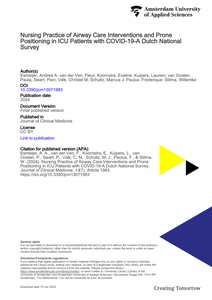We describe the incidence and practice of prone positioning and determined the association of use of prone positioning with outcomes in invasively ventilated patients with acute respiratory distress syndrome (ARDS) due to coronavirus disease 2019 (COVID-19) in a national, multicenter observational study, performed at 22 intensive care units in the Netherlands. Patients were categorized into 4 groups, based on indication for and actual use of prone positioning. The primary outcome was 28-day mortality. Secondary endpoints were 90-day mortality, and ICU and hospital length of stay. In 734 patients, prone positioning was indicated in 60%—the incidence of prone positioning was higher in patients with an indication than in patients without an indication for prone positioning (77 vs. 48%, p = 0.001). Patients were left in the prone position for median 15.0 (10.5–21.0) hours per full calendar day—the duration was longer in patients with an indication than in patients without an indication for prone positioning (16.0 (11.0–23.0) vs. 14.0 (10.0–19.0) hours, p < 0.001). Ventilator settings and ventilation parameters were not different between the four groups, except for FiO2 which was higher in patients having an indication for and actually receiving prone positioning. Our data showed no difference in mortality at day 28 between the 4 groups (HR no indication, no prone vs. no indication, prone vs. indication, no prone vs. indication, prone: 1.05 (0.76–1.45) vs. 0.88 (0.62–1.26) vs. 1.15 (0.80–1.54) vs. 0.96 (0.73–1.26) (p = 0.08)). Factors associated with the use of prone positioning were ARDS severity and FiO2. The findings of this study are that prone positioning is often used in COVID-19 patients, even in patients that have no indication for this intervention. Sessions of prone positioning lasted long. Use of prone positioning may affect outcomes.
DOCUMENT

INTRODUCTION: While prone positioning (PP) has been shown to improve patient survival in moderate to severe acute respiratory distress syndrome (ARDS) patients, the rate of application of PP in clinical practice still appears low.AIM: This study aimed to determine the prevalence of use of PP in ARDS patients (primary endpoint), the physiological effects of PP, and the reasons for not using it (secondary endpoints).METHODS: The APRONET study was a prospective international 1-day prevalence study performed four times in April, July, and October 2016 and January 2017. On each study day, investigators in each ICU had to screen every patient. For patients with ARDS, use of PP, gas exchange, ventilator settings and plateau pressure (Pplat) were recorded before and at the end of the PP session. Complications of PP and reasons for not using PP were also documented. Values are presented as median (1st-3rd quartiles).RESULTS: Over the study period, 6723 patients were screened in 141 ICUs from 20 countries (77% of the ICUs were European), of whom 735 had ARDS and were analyzed. Overall 101 ARDS patients had at least one session of PP (13.7%), with no differences among the 4 study days. The rate of PP use was 5.9% (11/187), 10.3% (41/399) and 32.9% (49/149) in mild, moderate and severe ARDS, respectively (P = 0.0001). The duration of the first PP session was 18 (16-23) hours. Measured with the patient in the supine position before and at the end of the first PP session, PaO2/FIO2 increased from 101 (76-136) to 171 (118-220) mmHg (P = 0.0001) driving pressure decreased from 14 [11-17] to 13 [10-16] cmH2O (P = 0.001), and Pplat decreased from 26 [23-29] to 25 [23-28] cmH2O (P = 0.04). The most prevalent reason for not using PP (64.3%) was that hypoxemia was not considered sufficiently severe. Complications were reported in 12 patients (11.9%) in whom PP was used (pressure sores in five, hypoxemia in two, endotracheal tube-related in two ocular in two, and a transient increase in intracranial pressure in one).CONCLUSIONS: In conclusion, this prospective international prevalence study found that PP was used in 32.9% of patients with severe ARDS, and was associated with low complication rates, significant increase in oxygenation and a significant decrease in driving pressure.
DOCUMENT
Background: Airway care interventions and prone positioning are used in critically ill patients with coronavirus disease 2019 (COVID-19) admitted to the intensive care unit (ICU) to improve oxygenation and facilitate mucus removal. At the onset of the COVID-19 pandemic, the decision-making process regarding the practice of airway care interventions and prone positioning was challenging. Objective: To provide an overview of the practice of airway care interventions and prone positioning during the second wave of the pandemic in the Netherlands. Method: Web-based survey design. Seventy ICU nurses, each representing one intensive care in the Netherlands, were contacted for participation. Potential items were generated based on a literature search and formulated by a multidisciplinary team. Questions were pilot tested for face and construct validity by four intensive care nurses from four different hospitals. Results: The response rate was 53/77 (69%). This survey revealed widespread use of airway care interventions in the Netherlands in COVID-19 patients, despite questionable benefits. Additionally, prone positioning was used in invasively and non-invasively ventilated patients. Conclusions: The use of airway care interventions and prone positioning is time consuming and comes with the production of waste. Further research is needed to assess the effectiveness, workload, and environmental impact of airway care interventions and prone positioning.
DOCUMENT
